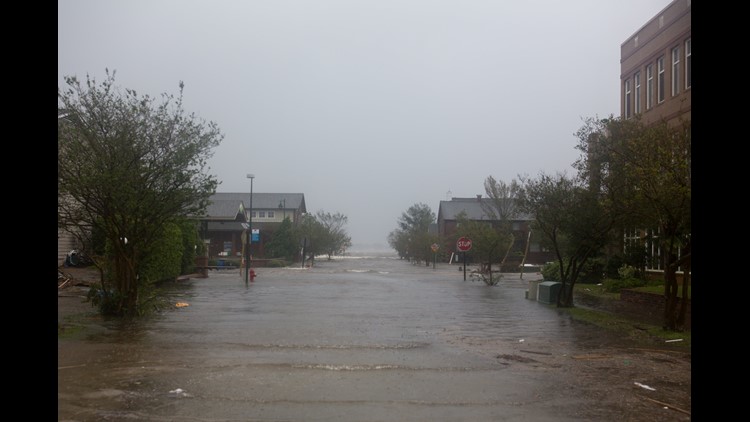After days of hoping for the best, Billy and Rita Sanderson waded in knee-high murky waters to see Florence’s storm damage to their home of nearly 30 years.
They passed a car buried in floodwaters Tuesday and called out to see if anyone was in it. When no one answered, they turned their attention to their white home with dark shutters partially submerged in the waters in front of them.
“That thing is a total loss,” Billy Sanderson told CNN affiliate WNCT, his voice breaking. “It’s just hard to explain. You’re going to have to start over, that’s all we can do.”
Florence made landfall as a Category 1 hurricane last week, and has killed at least 36 people, authorities said. Of those, 27 died in North Carolina, including in Duplin County, where the Sandersons live. Eight more people died in South Carolina and an additional person died in a storm-related tornado in Virginia.
Florence’s brutal aftermath
The Sandersons said they raised their home in 1999 after Hurricane Floyd nearly wiped it out.
But the aftermath of Florence’s deluge is so vicious, rivers and waterways are rising fast across the Carolinas, burying communities and roads, and preventing evacuees from going back home.
Florence is slowly moving northeast, where tornadoes associated with the storm hit Virginia. But even as it meanders off, at least 14 river gauges are at major flood stage, the North Carolina Emergency Management Agency tweeted.
Many of those waterways are rising or cresting, though a few were receding. Swollen rivers are gushing downstream toward flooded cities, putting more homes are at risk.
“I know for many people this feels like a nightmare that just won’t end,” North Carolina Gov. Roy Cooper said.
Governor to evacuees: Don’t go back home
Unlike the Sandersons, it’ll be a while before others can see the damage to their homes.
Cooper warned residents that the rain may have subsided, but the flooding danger is far from over. He asked evacuees to stay where they are and not return home just yet.
“To the approximately 10,000 people staying in our shelters and the countless more who are staying with friends and families or in hotels, I know it was hard to leave home and it’s even harder to wait,” Cooper said. “Please … do not try to return home yet.”
Evacuees from Pender and Brunswick counties should especially not go home due to flooding, he said.
More than 1,000 roads were closed across the state Tuesday, officials said, and about 343,000 people are still without power.
President Donald Trump is expected to visit the Carolinas on Wednesday to survey the storm damage.
Swollen rivers and glimmers of hope
One major concern is the Cape Fear River near Fayetteville, which has quadrupled in depth, and it’s only going to get worse.
Four days ago, the Cape Fear River was 15 feet deep. By Tuesday, it had topped 60 feet — and it still hasn’t crested.
Fayetteville city manager Doug Hewett said he’s concerned that with the rain gone, the residents may become complacent and try to get back home, which could be dangerous.
“We have 12,000 residents who could be in harm’s way if the river continues to rise,” he said.
Hewett said the river could crest to its highest historic level — about 62 feet — by Wednesday.
“We had significant rainfall .. and we’re still anticipating that some of the tributaries are draining into the upper Cape Fear. And if that happens, it will continue to rise until it crests,” he said.
But there are glimmers of hope in the wake of Florence.
For the first time since Florence ravaged North Carolina, residents in the island town of Wrightsville Beach were allowed to return home Tuesday.
But it will be a while before life gets back to normal. A curfew will be in place from 8 p.m. to 6 a.m., and access to the nearest big city on the mainland — Wilmington — is greatly limited.
‘This isn’t a river … this is Interstate 40’
Overflow from the river downstream has already created a new waterway on what used to be Interstate 40 in Pender County.
“This isn’t a river … this is Interstate 40,” the state’s transportation department tweeted, along with drone footage of the scene. “This illustrates our message that travel in this area is impassable and unsafe.”
Wilmington was the epicenter of Florence’s destruction. Rainfall totals of 26.58 inches have submerged much of the city, cutting it off from the rest of the state. It will have its wettest year in the city’s 140 years of record-keeping. More than 86 inches of rain have fallen so far. On average, Wilmington gets about 43 inches by this time of the year.
In Lumberton, where residents scrambled to plug the levee system, parts of Interstate 95 will remain closed until the Lumber River drops below 21 feet. That might not happen until next week, said Corey Walters, the city’s deputy director of public works.
But it’s impossible to say how deep the Lumber River is now, because the official river gauge stopped working a few days ago. Walters estimated the current depth is about 25 feet.



